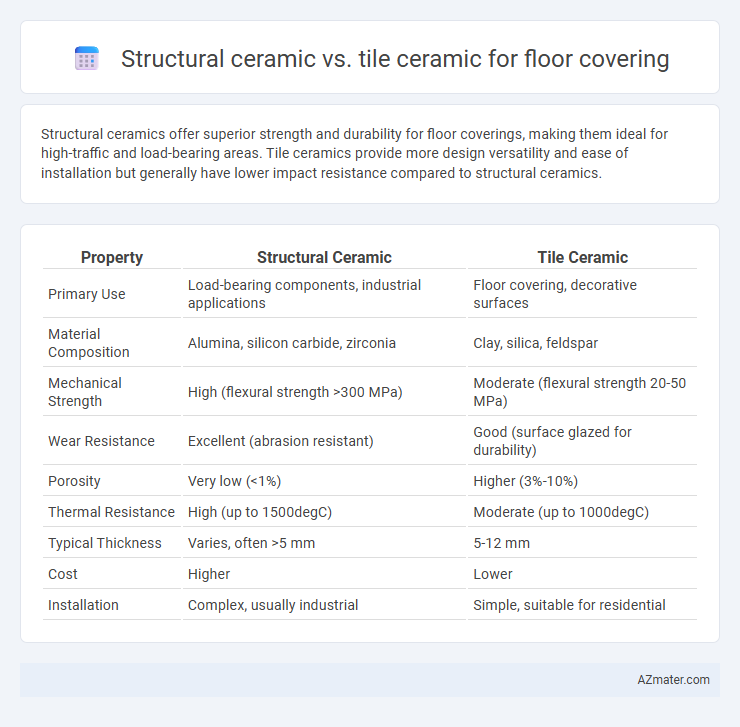Structural ceramics offer superior strength and durability for floor coverings, making them ideal for high-traffic and load-bearing areas. Tile ceramics provide more design versatility and ease of installation but generally have lower impact resistance compared to structural ceramics.
Table of Comparison
| Property | Structural Ceramic | Tile Ceramic |
|---|---|---|
| Primary Use | Load-bearing components, industrial applications | Floor covering, decorative surfaces |
| Material Composition | Alumina, silicon carbide, zirconia | Clay, silica, feldspar |
| Mechanical Strength | High (flexural strength >300 MPa) | Moderate (flexural strength 20-50 MPa) |
| Wear Resistance | Excellent (abrasion resistant) | Good (surface glazed for durability) |
| Porosity | Very low (<1%) | Higher (3%-10%) |
| Thermal Resistance | High (up to 1500degC) | Moderate (up to 1000degC) |
| Typical Thickness | Varies, often >5 mm | 5-12 mm |
| Cost | Higher | Lower |
| Installation | Complex, usually industrial | Simple, suitable for residential |
Introduction to Ceramic Flooring Materials
Structural ceramics used in floor covering provide high durability, superior mechanical strength, and resistance to abrasion, making them ideal for heavy traffic areas. Tile ceramics, composed primarily of clay and other natural materials, offer diverse aesthetic options with glazed surfaces that enhance water resistance and ease of maintenance. Both materials excel in thermal stability and chemical resistance, but structural ceramics emphasize structural integrity while tile ceramics prioritize design versatility.
Defining Structural Ceramics
Structural ceramics are engineered materials designed to withstand high mechanical stress, abrasion, and thermal variations, making them ideal for demanding floor covering applications. Unlike tile ceramics, which primarily emphasize aesthetic appeal and surface durability, structural ceramics offer superior strength, fracture toughness, and longevity. These properties result from advanced compositions and manufacturing processes, enabling their use in industrial flooring and high-traffic areas where performance and resilience are critical.
Defining Tile Ceramics
Tile ceramics, primarily composed of clay and minerals, are engineered for floor coverings through firing at high temperatures to achieve durability and water resistance. Unlike structural ceramics used in industrial applications for mechanical strength and heat resistance, tile ceramics prioritize aesthetic appeal, surface finish, and slip resistance. The manufacturing process includes glazing and polishing, enhancing tile ceramics' suitability for flooring in residential and commercial environments.
Key Material Composition Differences
Structural ceramics for floor covering mainly consist of high-density alumina and silicon carbide, providing exceptional strength and durability for heavy-duty applications. Tile ceramics primarily use kaolin, feldspar, and quartz, which offer aesthetic versatility and moderate hardness suitable for residential and commercial spaces. The key difference lies in structural ceramics' engineered microporosity and reinforced crystalline phases that enhance mechanical performance compared to the relatively porous and vitrified composition of tile ceramics.
Mechanical Strength and Durability Comparison
Structural ceramics exhibit superior mechanical strength and durability compared to tile ceramics, making them ideal for heavy-load floor coverings in industrial and commercial settings. Their high fracture toughness and resistance to wear and impact outperform conventional tile ceramics, which are more prone to chipping and cracking under stress. Structural ceramics' enhanced density and low porosity contribute to prolonged lifespan and consistent performance in demanding floor applications.
Water Absorption and Porosity Factors
Structural ceramics exhibit significantly lower water absorption rates, typically below 0.5%, making them highly resistant to moisture penetration and ideal for high-traffic, wet-area flooring. Tile ceramics, while widely used in floor coverings, often have higher porosity and water absorption values ranging from 3% to 7%, which can affect durability and stain resistance over time. The lower porosity of structural ceramics enhances mechanical strength and frost resistance, providing superior performance in both indoor and outdoor flooring applications.
Installation Methods and Techniques
Structural ceramics for floor covering require precision installation methods such as dry press forming and careful joint alignment to ensure durability and mechanical strength. Tile ceramics utilize adhesive bonding techniques like thin-set mortar application, allowing for flexibility and ease of replacement. Both methods demand surface preparation; structural ceramics need a solid, flat substrate, while tile ceramics benefit from a clean, level base to prevent cracking and ensure long-term performance.
Aesthetic and Design Options
Structural ceramics offer a wide range of colors, textures, and finishes that enhance aesthetic appeal while maintaining durability in flooring applications. Tile ceramics provide more versatile design options, including intricate patterns, varied shapes, and customizable sizes, allowing for greater creativity in interior design. Both materials support high-quality finishes, but tile ceramics are preferred for achieving complex and visually striking floor coverings.
Cost Analysis and Return on Investment
Structural ceramics offer higher durability and mechanical strength than tile ceramics, resulting in lower maintenance and replacement costs over time. Tile ceramics generally have a lower upfront cost but may require more frequent repairs or replacements, increasing long-term expenses. Considering return on investment, structural ceramics provide greater value in high-traffic or industrial flooring applications due to their extended lifespan and reduced total cost of ownership.
Best Applications: Structural vs Tile Ceramics
Structural ceramics excel in high-stress environments due to their superior mechanical strength and resistance to wear, making them ideal for industrial flooring, heavy machinery bases, and areas subject to extreme pressure. Tile ceramics, designed primarily for aesthetic appeal and moderate durability, suit residential or commercial floor coverings where decorative patterns and ease of cleaning are prioritized. Choosing between structural and tile ceramics depends on load-bearing requirements, environmental conditions, and design preferences, with structural ceramics favored for functional durability and tile ceramics for visual enhancement.

Infographic: Structural ceramic vs Tile ceramic for Floor covering
 azmater.com
azmater.com